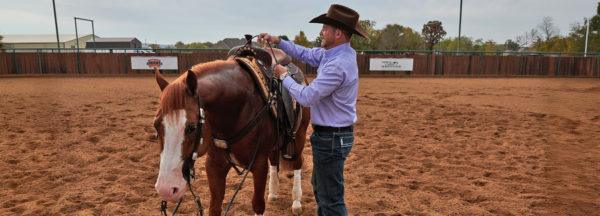Training Tip: How to Correctly Saddle a Horse


Training Tip: Correctly Saddling a Horse
Clinton Anderson from Downunder Horsemanship has developed a way to train horses, regardless of their past problems or traumas. It all begins with training the owners so they can gain their horses’ respect and understand how to properly control them. Join Clinton on his weekly endeavors of tackling some of the most challenging situations with problem horses and problem owners. This week, we watch as Clinton gives us a new training tip on how to correctly saddle a horse.
Clinton reminds us about his last lesson, where he demonstrated how to back a horse up and down the alleyway of a barn. He reiterates one of the core takeaways from that lesson—backing fixes a lot of unwanted issues like biting and dominant behavior. In fact, backing up a horse can help mentally change a horse’s entire attitude.
So, this week, Clinton starts with his horse tied up in the saddling bay. He prefers to tie his horses up using an Aussie Tie Ring rather than cross ties, as he thinks cross ties can be dangerous. Clinton sometimes makes an exception to using cross ties when he’s at a horse show, but otherwise, it’s better to simply tie the horse up. This way, when you want to move your horse, all you need to do is put a little bit of steady pressure on them and they’ll move away from it. You can learn more about this method in Clinton’s Intermediate Series exercises Touch and Rub. Every time that you get your horse to move away from you, you’re gaining a little more respect. Every time your horse makes you move your feet; they’re getting a little more disrespectful.
To saddle your horse, you first put the saddle pad on them. Here, Clinton is using one of his PRS Pads, which is available on the website. It’s a great saddle pad that helps reduce the chance of your horse getting dry spots. Next, Clinton tells viewers how he prefers to saddle his horses from the offside (right side). Therefore, he moves his horse over out of the road and puts the saddle on. Clinton prefers to saddle from the offside because it allows him to easily put down the breast collar and work with the cinches. Next, you need to adjust the saddle pad and make sure there’s no mane underneath it. Clinton stresses the importance of being conscious of how you’re putting on the saddle and prioritizing comfort for both you and your horse.
As always, Clinton stresses safety and not putting yourself in a dangerous situation where you could get trapped up against a wall if the horse reacted badly or got startled. Even when you’re saddling a seasoned horse, it’s crucial that you identify an escape door that can be used in case something bad happens. Ask yourself, “How am I going to get out of this situation?” and keep that in mind during the entire saddling process. Once the pad and saddle are correctly placed on the horse, you can do the front cinch up, the back cinch up, and then put on the breast collar. However, Clinton tells us that this technique should only be used for seasoned horses, not inexperienced or green horses that have only been saddled a few times in their life. For those horses, you need to be in an open area like a roundpen or an arena—not the stall.
One of the best ways to get a horse to get cranky about being saddled and end up wanting to buck with the saddle is to put the saddle on and then jerk the cinch up as hard as you can. That’s basically the equivalent of getting out of bed, putting your underwear on, and then having someone come up behind you and give you a massive wedgie. It’s not a good way to start the day. So, regardless of if you’re in a hurry or not, take your time with saddling your horse and be gentle.
Clinton recommends doing the girth up in three different stages to help your horse acclimate—kind of light when you first do it up, medium after doing a bit of groundwork with the horse, and pretty darn firm right before you get in the saddle. Keep in mind that there is such a thing as too tight, so don’t go overboard here. Saddling your horse is a part of training, so if other people saddle your horse it’s important that everyone is on the same page about how to interact with your horse and the saddling process.
To learn more about the Downunder Horsemanship training method, become a member of the No Worries Club, or get information on any of the products seen on our show, head over to our homepage and download the Downunder Horsemanship app today!

